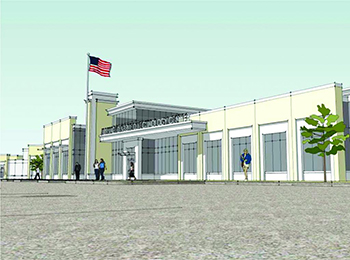Q&A: Alamance Community College’s New Training Center
 GRAHAM, N.C. — Construction on Alamance Community College’s $15 million Advanced Applied Technology Center is scheduled to begin next summer in Graham. The much-anticipated, one-level structure will provide more room and functionality than a previous two-level design.
GRAHAM, N.C. — Construction on Alamance Community College’s $15 million Advanced Applied Technology Center is scheduled to begin next summer in Graham. The much-anticipated, one-level structure will provide more room and functionality than a previous two-level design.
Charlotte, N.C.-based Rodgers Builders will serve as the construction manager, while the architect is Little Diversified Architectural Consulting, with offices in Durham, N.C. School Construction News spoke with Rob Klinedinst, AIA, LEED BD+C, studio principal for Little Diversified Architectural Consulting, about the project and the differences in designing for community college programs.
Q: What is the main goal of the project?
Klinedinst: The new 55,000-square-foot, state-of-the-art Advanced Applied Technology Center at Alamance Community College will provide a much-needed new home with adequate space and specialized equipment for growing programs in Computer-Integrated Machining Technology; Welding Technology; Air Conditioning, Heating and Refrigeration Technology; and Automotive Systems Technology. These programs are currently housed in outdated and undersized spaces, which have limited capacity for growth or the acquisition of new cutting-edge equipment. More than twice the existing area for each program will be provided to allow for growth.
Q: What are some of the project’s key design elements?
Klinedinst: The Advanced Applied Technology Center will showcase technical learning and training. Its location on campus is front and center making it highly visible. A central commons will be used to display student projects, provide flexible space for interdisciplinary projects and hold career fairs so students can connect with potential employers. The building is configured to allow visibility into each lab to showcase technology and to attract new students.
High-performance features are being incorporated into the design to meet LEED Silver requirements. The building envelope is being optimized to reduce energy use, and a rigorous daylighting analysis has been performed to maximize natural light to provide prescribed lighting levels within each lab and reduce operating costs.
Q: What are some of the major security elements?
Klinedinst: Safety is a critical element in the planning for the new Advanced Applied Technology Center. Flammable gases and hazardous fumes are present in the labs. Providing safe conditions for training is just as important as providing safe conditions in the work environment. Through multiple visits to the existing labs and meeting with department representatives, the design team has acquired an understanding of the curriculum and prepared a comprehensive life safety and building code analysis.
Q: Has the project encountered any challenges?
Klinedinst: The topography of the site posed the biggest challenge. Grades drop off significantly around the site. The building design has progressed to minimize site and building construction costs through the development of a single-story building, which minimizes the footprint, eliminating expensive stairs, elevators and retaining walls.
Q: How is designing for a community college different than designing for other educational settings?
Klinedinst: Many graduates of the Advanced Applied Technology Center will find employment in the community. Programs are geared specifically to needs in the county and local companies have a vested interest in the educational pipeline that feeds their needs. Numerous local businesses showed support for the project as it was being considered by the Alamance County Board of Commissioners. Representatives from some of those companies sit on the Advisory Committee that is overseeing the design of the project. This local interest and involvement in the project and the influence a project has in economic development is unique to community college projects.
